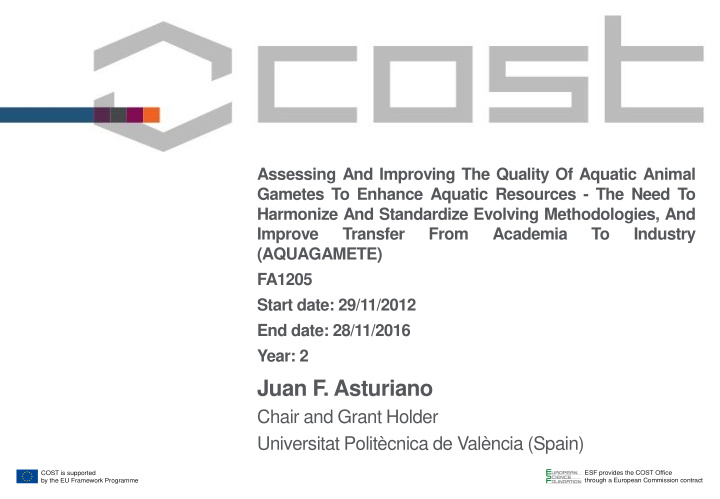



Assessing And Improving The Quality Of Aquatic Animal Gametes To Enhance Aquatic Resources - The Need To Harmonize And Standardize Evolving Methodologies, And Improve Transfer From Academia To Industry (AQUAGAMETE) FA1205 Start date: 29/11/2012 End date: 28/11/2016 Year: 2 Juan F. Asturiano Chair and Grant Holder Universitat Politècnica de València (Spain) COST is supported ESF provides the COST Office by the EU Framework Programme through a European Commission contract
Scientific context and objectives (1/2) • Background / Problem statement: Europe needs aquatic animal species. Aquaculture has compensated the reduction of captures, centered in controlled-reproduction species. To promote the aquaculture of other species, quality and storage of gametes need to be addressed. However, the extreme diversity of fish species, evaluation techniques, cryopreservation protocols, etc. make necessary to standardize protocols and methodologies for reporting results. • Brief reminder of MoU objectives: 1) To review the current state of knowledge on aquatic species gametes. 2) To coordinate activities dedicated especially to intercalibration and standardization of techniques of analysis, and to identify gaps in research and technology, to avoid overlapping research and to transfer to industry. 3) To reach a consensus on protocols and guidelines that permit the use of results in relational studies. 4) Maximize the dissemination of results. 2
Scientific context and objectives (2/2) • Research directions: 1. Standardization of techniques for evaluation of gametes quality 2. Development and standardization of sperm cryopreservation techniques 3. Innovative research on gametes biochemistry (physiology, genomics, proteomics … ) 3
Working groups 1. Techniques for evaluation of gametes quality 2. Gametes storage and preservation 3. Basic and applied research on gametes biochemistry and physiology, including omics. 4. Organization of training courses, coordination meetings, and two editions of International Workshops on Biology of Fish Gametes 4
Action Parties 25 22 20 18 15 Grant Holder: Universitat Politècnica de València 10 Dr. Juan F. Asturiano 5 4 Spain 0 0 YR 1 YR 2 YR 3 YR 4 Parties Non-COST Countries 5
Action participants 400 355 350 300 Total no. of indiv. 250 200 participants 200 191 ESRs 151 150 117 93 100 Female 50 0 YR 1 YR 2 YR 3 YR 4 6
Use of COST Instruments Activity (No.) Year 1 Year 2 Year 3 Year 4 MC/WG Meetings 2 2 STSMs 31 (25) Training Schools 1 3 Workshops or 1 1 Conferences Joint Publications 0 0 7
Results vs. Objectives • The progress towards reaching the Action scientific objectives during the past year are described below: • The state of the art on several aspects of aquatic species gametes is being reviewed. • Intercalibration and standardization of techniques of analysis were and are being addressed in several of the 31 STSMs supported during the first GP; in the 4 th IWBFG, a special session dedicated to standardization was useful for identification of gaps and to avoid overlapping research. • The standardization session in the 4 th IWBFG, first attempts on stardardization of protocols for cryopreservation of fish gametes and the redaction of a cryopreservation guideline (innovative work) represented an improvement to reach a consensus on protocols that permit the use of results in relational studies. • As dissemination of results, a special number of the Journal of Applied Ichthyology will be published (2014) dedicated to the 4 th IWBFG (innovative work) and the redaction of several review papers is being coordinated by leader of WG3. • In the 4 th IWBFG, a total of 107 communications were presented by 107 participants. 8
Significant Highlights in Science or Networking (1/2) • Training School “Techniques for fish germline cryobanking ”, held in Cádiz, Spain, during 5 days in 2013, with 20 trainees and13 trainers. 9
Significant Highlights in Science or Networking (2/2) • 4 th International Workshop on the Biology of Fish Gametes, held in Albufeira, Portugal, during 4 days in September 2013, with 118 participants from 24 countries, who presented 107 communications. 10
Challenges • “Standardization of procedures ” needs our attention • The activity of all WGs need a further effort (i.e. new training schools). 11
Recommend
More recommend